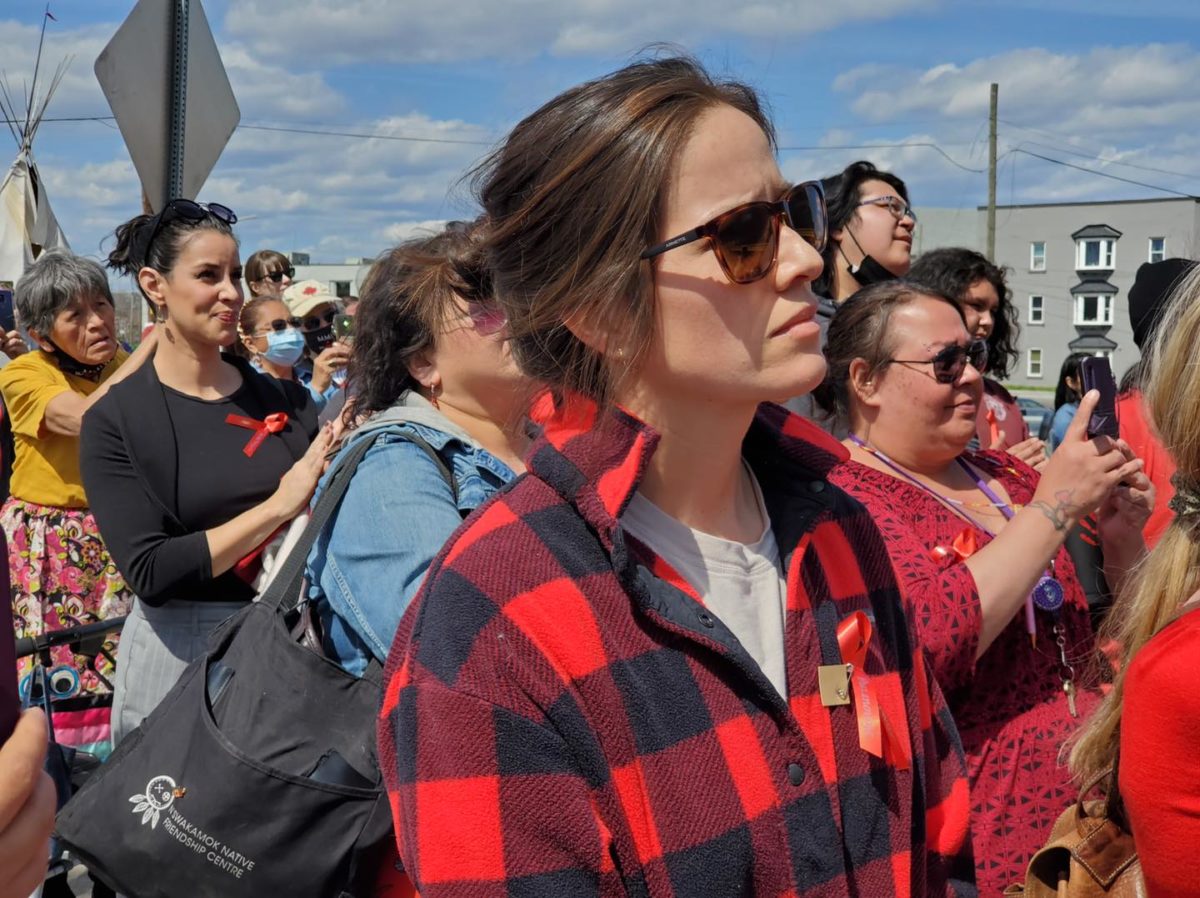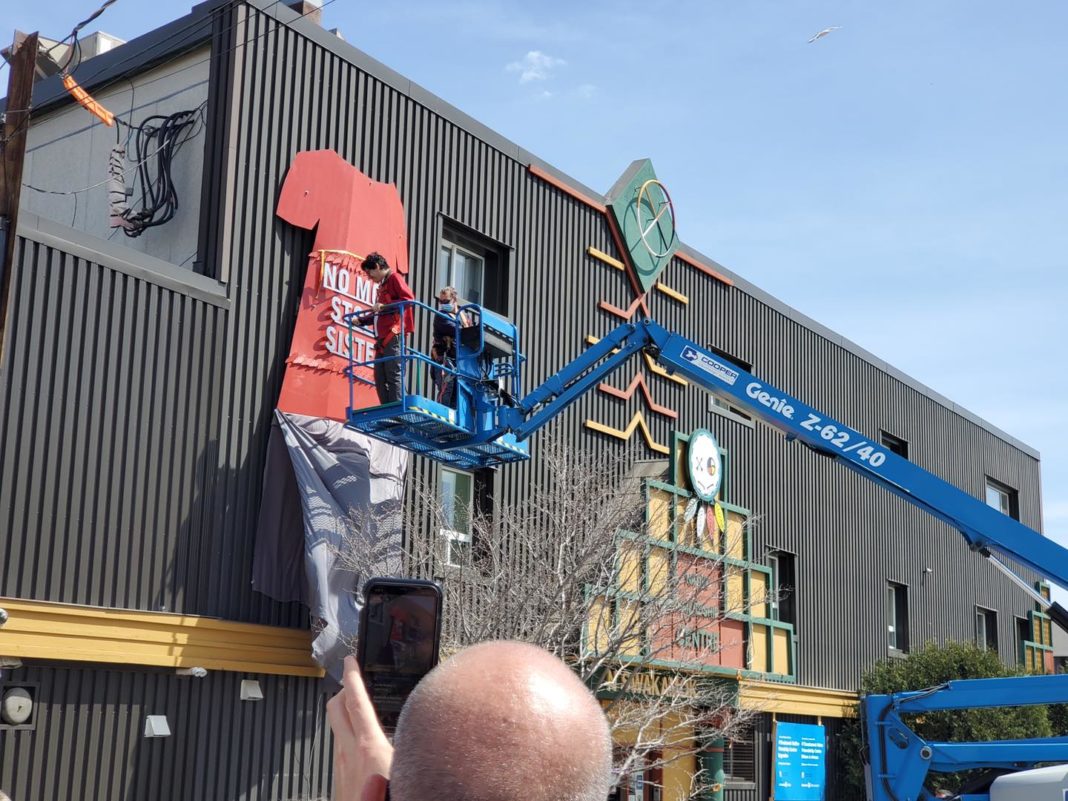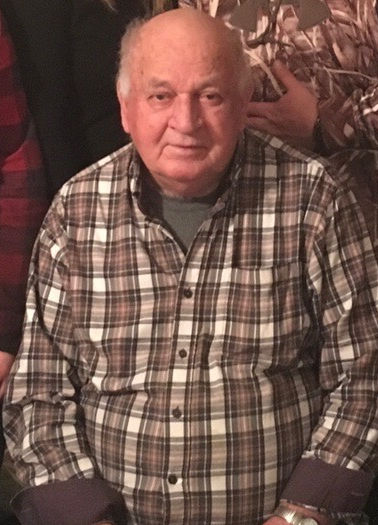Friendship centre unveils new One Kwe sculpture on Red Dress Day
SUDBURY—Kathryn Corbiere stood and watched, just another face amongst the crowd in Sudbury. A women’s hand drum group sang an honour song as the crowd gazed toward a veiled sculpture in anticipation. Ms. Corbiere knew what was underneath, but not even she could predict what it might mean for the sea of people around her.
“I just hope the families like it,” Ms. Corbiere quietly told this reporter.
The knot released and the shroud dropped, revealing a bright red dress branded with the words ‘no more stolen sisters.’ It was Ms. Corbiere’s latest sculpture, made in honour of Red Dress Day, May 5.
People at the gathering, each wearing a red ribbon in honour of missing and murdered Indigenous women and girls (MMIWG), applauded as the metal sculpture came into view.
With thousands of incidents of missing and murdered Indigenous women, girls and two-spirit people across Canada, the crisis has affected more families, friends and communities than it may seem.
This sculpture, located on Sudbury’s N’Swakamok Native Friendship Centre in view of busy Elm St., was to serve as both a memorial and a call to action.

The red dress has been a symbol of MMIWG since 2010, the year of the first Red Dress Day. It’s an annual event to mark the disproportionately high rates of violence toward Indigenous women, girls and two-spirit people.
According to the Assembly of First Nations, Indigenous women face violence at rates three times higher than non-Indigenous women. Statistics on homicides follow similar trends.
The MMIWG crisis has impacted Manitoulin Island, too. It is not uncommon to see a red dress hanging in a tree or from a welcome sign at many of the Island’s First Nations. Each dress represents a stolen sister, mother or daughter.
Ms. Corbiere’s red dress sculpture began through a partnership between the friendship centre and Greater Sudbury Police Service (GSPS). It’s a project called ‘Looking Ahead to Build the Spirit of Our Women – Learning to Live Free from Violence,’ which aims to reduce victimization and raise awareness of MMIWG.
“I’m always a little nervous anticipating the unveiling,” Ms. Corbiere said, “especially with something so important and meaningful. The statistics are horrific.”
The police force contacted Ms. Corbiere, who makes art under the name One Kwe, to commission the sculpture. It stands 12 by eight feet and features bent metal feathers to create a sense of movement and recreate the look of a ribbon skirt. Tony Nutt of Build North Construction donated materials and labour for the install.
Ms. Corbiere, who is from M’Chigeeng, said the sculpture had a deeper personal meaning.
“I take great pride in creating these pieces, as a two-spirit Anishinaabe-kwe. It makes me realize that this could happen to me,” she said.
Emcee Autumn Lewis first introduced elder and nookomis Martina Osawamick, who thanked Ms. Corbiere for her “beautiful design which we are pleased to unveil today.”
GSPS’ deputy police chief Sara Cunningham also credited Ms. Corbiere and shared the history of the partnership.
Ogimaa Larry Roque of Wahnapitae First Nation said he hoped the sculpture would help foster discussions of MMIWG beyond the annual Red Dress Day.
“We need (MMIWG) to stop,” the ogimaa said, imploring everyone in attendance to take some action to address the crisis.
Atikameksheng Anishnawbek Councillor Jennifer Petahtegoose said the sculpture would help to honour the path that many women have walked.
Hope Osawamick read remarks on behalf of her mother Lisa, who could not attend. Lisa Osawamick, of Wiikwemkoong, was the first to oversee Indigenous women’s violence prevention for the friendship centre-GSPS partnership.
“So many loved ones have disappeared,” Hope said. “Today, I will acknowledge and celebrate the imprints we are leaving here for the next generation.”
Juliette Wemigwans, whose family came from M’Chigeeng, remembered her sister, who she believed was murdered.
“There’s a lot to be said with ‘out of sight, out of mind.’ It’s no longer out of sight or out of mind,” Ms. Wemigwans said, referring to the sculpture. Shannon Agowissa of Atikameksheng shared a similar sentiment shortly thereafter, saying “we’re not putting up with this anymore.”
GSPS Indigenous liaison officer Daryl Rivers, who is from Wiikwemkoong, said police have to work hard to restore trust with Indigenous peoples.
“The number of (MMIWG) is disproportionate to the number of Indigenous people. With that, there can come a lack of faith in police,” he said.
However, he said GSPS has served as a model for its ongoing relationship re-building.
“As an Indigenous person, I would want all Indigenous people across the province to get the same care as they’d get in Sudbury.”
N’Swakamok Native Friendship Centre’s executive director Marie Meawasige thanked the federal Department for Women and Gender Equity for funding the project.
“This artwork has been designed to honour all the (MMIWG) and their family members,” she said.
As the crowds began to thin, Ms. Corbiere said she hoped it would drive conversations and reflections in the years to come.
“That’s why I like metal. When you look at graffiti, murals will fade over time. But this sculpture will be here as long as this building stands,” she said.
Victims of domestic violence are not alone. If you have been assaulted by an intimate partner or know someone who has, there are local resources here to help. The Manitoulin Family Resources website at MFResources.net can provide assistance. A toll-free call can also be placed to the Assaulted Women’s Helpline at 1-866-863-0511 where your information will remain anonymous and confidential. If you are in an immediate crisis, dial 9-1-1.





